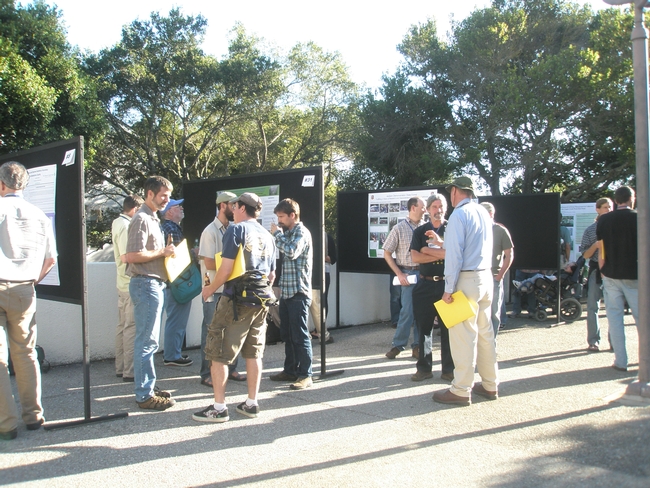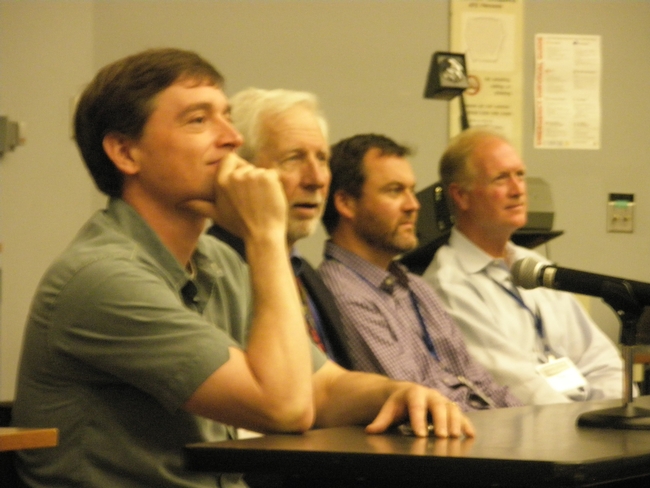The Coast Redwood Forests in a Changing California Science Symposium was held June 21-23, 2011, at UC Santa Cruz with just under 300 registrants in attendance. Participants ranged in background from graduate level students to university forestry and natural resource faculty, land managers, conservation groups, public agencies, and land trust members. The symposium was strategically held in Santa Cruz, near the Southern end of the redwood region. Designed to present the state of our knowledge about California’s coast redwood forest ecosystems and sustainable management practices, this symposium was built on earlier redwood science symposia held in Arcata, CA in June, 1996 and in Santa Rosa, CA in March, 2004. The symposium was jointly organized by the forestry programs at UC Berkeley, Cal Poly San Luis Obispo, and Humboldt State University, and partially supported by a grant designed to encourage research and outreach collaboration between the University of California and the California State University systems.
Attendees participated in a day long field trip and two days filled with opening sessions, concurrent presentations on research and management case studies, and a poster session. An ongoing theme of the symposium was the need for action and collaboration from all directions, including public and private land owners and managers, as well as academics and policy makers.

During the opening panel, local historian Sandy Lydon gave a synopsis of the settlement of the area and how the redwoods will always have a special history in the region. He recounted stories from his boyhood about roaming through the forests. He reminded the audience to take time from their schedules to spend time in the forests, and to urge their children to play outside to develop an appreciation for the outdoors and cultivate their imaginations.
Ruskin Hartley, Executive Director and Secretary of Save the Redwoods League, questioned what it means to save the redwoods today and argued that buying and placing land in public ownership is not enough. He believes the next 100 years will focus on restoring forests collaboratively between public and private entities. Hartley called on the audience to set “audacious goals and take collaborative actions.” He maintained that nature does not develop boundaries and that in moving forward, we should focus on a shared set of goals so that public and private land can progress simultaneously. In a time of climate change, the lines we draw on maps become increasingly irrelevant, instead we need a new paradigm to “think about building resilience and adaptability to climate change into the system to benefit both public and private owners.”
Ron Jarvis, Home Depot’s Vice President of Sustainability talked candidly about the role of environmental sustainability practices and policies as part of the home improvement retailer’s business model. He noted that when he began in the sustainability department he undertook a two year long project to understand where every sliver of wood from over 9,000 products originated to ensure sustainable wood practices. Recently, Home Depot sent a memo to their current vendors asking them to supply Home Depot with the names of their “green products.” The green product inventory exceeded over 10,000 products, yet when Jarvis’s team investigated further they deemed only about 2,000 to be worthy of the green standard. Jarvis showed that products today, because of packaging or brand names, may seem green, but the consumer must really investigate what they are buying. Jarvis hopes that in his position he can take some of that burden off of the consumer so that the majority of products that reach Home Depot shelves have already passed the test.

During the concluding ceremony on the future of research in the redwood region, the panel, as well as audience members, recognized the need for more communication among those working with redwoods to spread research findings and best practices. Inspired by the concurrent presentations and research presented at the poster session, participants were looking for a way to stay in touch and collaborate - as Hartley noted in the opening session is crucial for the next steps of redwood growth and preservation. 100% of participants who completed the follow up survey are excited to network and collaborate at similar events, meaning there are opportunities to further enhance the redwood and green movements.
Proceedings of the symposium are anticipated to be available in early Fall 2011 to document the various studies in the literature.
For a full summary of the 2011 Redwood Symposium, please visit: The Forest Research and Outreach Blog.
For ways you can get involved or if you have ideas for collaboration: Like us on Facebook and join the discussion!